Power Services Group (PSG) was contracted by an industrial customer in the Midwest U.S. to perform a major inspection of their Allis-Chalmers steam turbine generator.
This unit is a non-condensing steam turbine that is directly coupled to an Allis-Chalmers air cooled generator. The turbine and generator set are of a three-bearing
design.
During the project, a Safety Meeting was held prior to the start of any work. The Safety Meeting topics were based on work activities to be performed during the shift. In addition, hazardous observations which could impact the safety of the team were discussed and resolved. Prior to performing work, a Job Safety Analysis (JSA) form was completed by the work team. This project had no accidents and no first aid incidents.
The steam path components, once removed, were dust blasted and received nondestructive examination (NDE). The NDE revealed minor indications on the stationary blading, and no repairs were deemed necessary at this time. The turbine rotor and stationary stage 6 were shipped to our steam path component inspection and repair facility in Pevely, Missouri for replacement of the 7, 8, 9 and 10 rotating blades, and repairs to the #6 stationary stage.
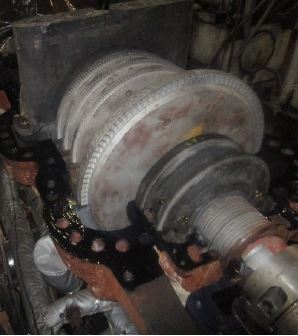
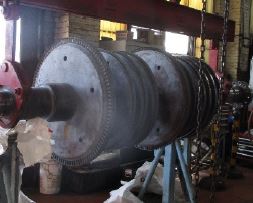
The generator field was removed from the stator and both the generator field and generator stator, received visual inspections and electrical testing. The generator field was shipped out to receive a retaining rings-off inspection. The stator was ice blast cleaned, received a re-wedge of the stator core windings, and final coated with an insulating epoxy. The journal bearings were removed and visually and dimensionally inspected and received dye-penetrant and ultrasonic testing. Inspections revealed that all of the bearings, new and in service, were in excellent condition. The pedestal oil deflectors were removed and visually and dimensionally inspected. All were found to be beyond industry standard clearance tolerances and were replaced.
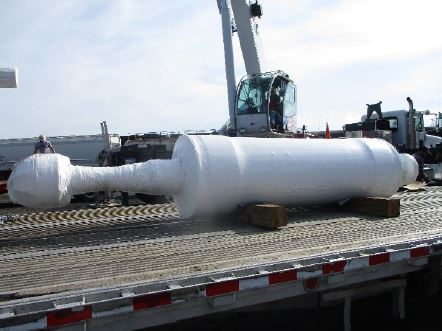
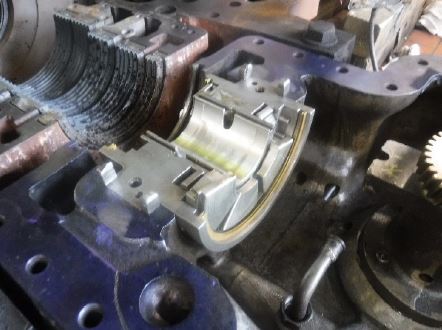
The inlet control and extraction control valve racks were removed, cleaned and visually and dimensionally inspected. The valve poppets and seats were NDE inspected and found to be in very good condition and were returned to service. Some of the valve linkage bushings and pins were found to be worn and were replaced. The trip throttle valve (TTV) and operator were removed, disassembled, cleaned, and inspected. All inspections were approved and the components were returned to service. The lube oil cooler was removed and replaced by plant personnel. The lube oil system shaft driven main and steam driven auxiliary oil pumps were removed and received inspections. The main oil pump (MOP) and the steam driven auxiliary oil pump, (AOP) were found to be in good condition and were reassembled and returned to service. The lube oil reservoir was opened by PSG and initially cleaned by plant personnel. Some sediment and sludge were found during the initial cleaning of the lube oil main reservoir. PSG performed a final vacuum and hand cleaning of the interior of the reservoir prior to the lube oil system high velocity oil flush (HVOF). A lube oil system HVOF was performed utilizing an external pump and heating/filtering skid. The flush was ran for approximately 72 hours and was completed once system cleanliness was acceptable.
The system trip devices were inspected, cleaned and flushed; all linkages were checked for wear and proper freedom of movement. The mechanical over speed trip test was completed after initial startup and the unit was later tied on-line. PSG personnel demobilized the job site and were released to travel after another successful project startup.
Zero safety incidents, quality work, Nice job team!
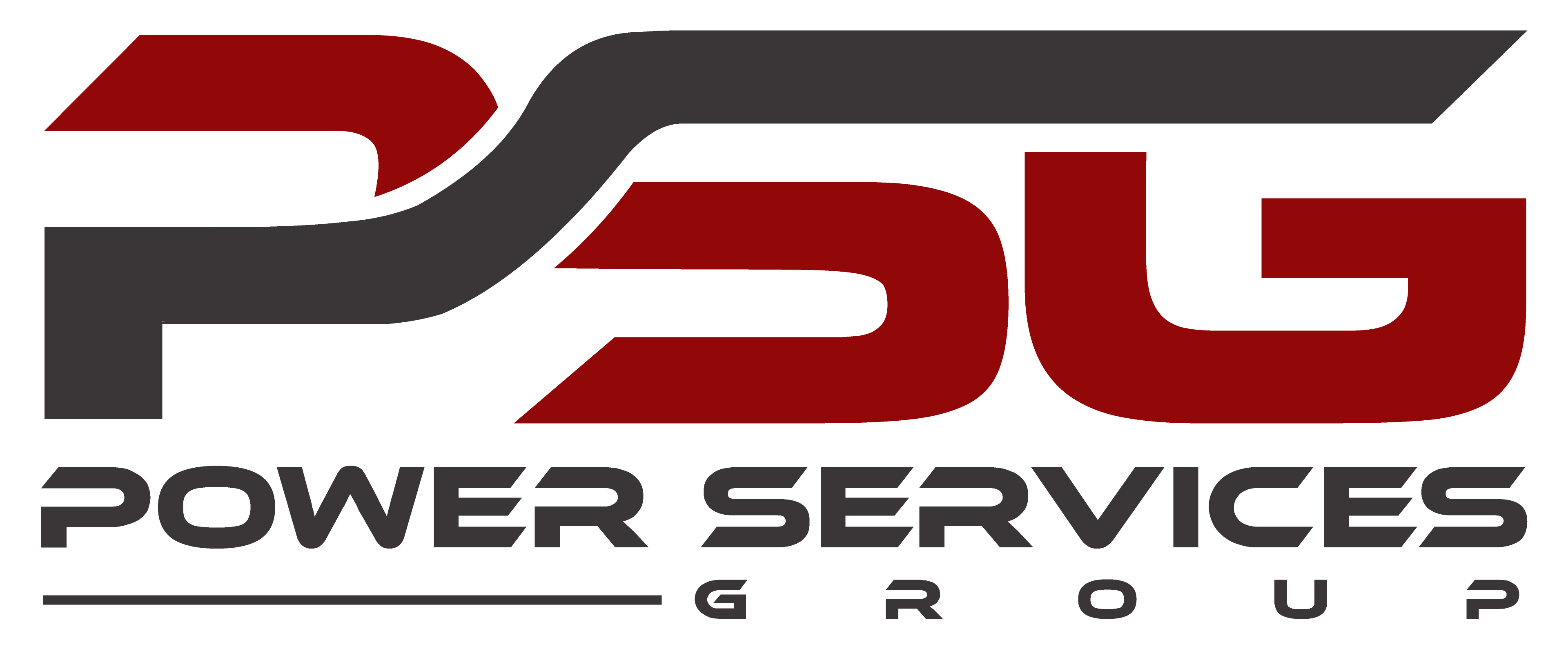
Stud Hole Repair/Restoration
/in News /by Mike.LakeWe were recently contracted by an industrial customer in the Midwest to repair stud holes on a piece of equipment at their facility. This is a common repair we perform, and is executed utilizing our specialty equipment and skilled technicians. The photos below will show the mill that is mounted to the face of the surface that will have the stud hole repaired. The hole is bored and tapped, and a threaded insert is installed. Great work by our team!
Happy Independence Day!
/in Events /by Mike.LakeAllis-Chalmers Industrial Steam Turbine Major Inspection
/in News, Steam Turbine Tips /by Mike.LakePower Services Group (PSG) was contracted by an industrial customer in the Midwest U.S. to perform a major inspection of their Allis-Chalmers steam turbine generator.
This unit is a non-condensing steam turbine that is directly coupled to an Allis-Chalmers air cooled generator. The turbine and generator set are of a three-bearing
design.
During the project, a Safety Meeting was held prior to the start of any work. The Safety Meeting topics were based on work activities to be performed during the shift. In addition, hazardous observations which could impact the safety of the team were discussed and resolved. Prior to performing work, a Job Safety Analysis (JSA) form was completed by the work team. This project had no accidents and no first aid incidents.
The steam path components, once removed, were dust blasted and received nondestructive examination (NDE). The NDE revealed minor indications on the stationary blading, and no repairs were deemed necessary at this time. The turbine rotor and stationary stage 6 were shipped to our steam path component inspection and repair facility in Pevely, Missouri for replacement of the 7, 8, 9 and 10 rotating blades, and repairs to the #6 stationary stage.
The generator field was removed from the stator and both the generator field and generator stator, received visual inspections and electrical testing. The generator field was shipped out to receive a retaining rings-off inspection. The stator was ice blast cleaned, received a re-wedge of the stator core windings, and final coated with an insulating epoxy. The journal bearings were removed and visually and dimensionally inspected and received dye-penetrant and ultrasonic testing. Inspections revealed that all of the bearings, new and in service, were in excellent condition. The pedestal oil deflectors were removed and visually and dimensionally inspected. All were found to be beyond industry standard clearance tolerances and were replaced.
The inlet control and extraction control valve racks were removed, cleaned and visually and dimensionally inspected. The valve poppets and seats were NDE inspected and found to be in very good condition and were returned to service. Some of the valve linkage bushings and pins were found to be worn and were replaced. The trip throttle valve (TTV) and operator were removed, disassembled, cleaned, and inspected. All inspections were approved and the components were returned to service. The lube oil cooler was removed and replaced by plant personnel. The lube oil system shaft driven main and steam driven auxiliary oil pumps were removed and received inspections. The main oil pump (MOP) and the steam driven auxiliary oil pump, (AOP) were found to be in good condition and were reassembled and returned to service. The lube oil reservoir was opened by PSG and initially cleaned by plant personnel. Some sediment and sludge were found during the initial cleaning of the lube oil main reservoir. PSG performed a final vacuum and hand cleaning of the interior of the reservoir prior to the lube oil system high velocity oil flush (HVOF). A lube oil system HVOF was performed utilizing an external pump and heating/filtering skid. The flush was ran for approximately 72 hours and was completed once system cleanliness was acceptable.
The system trip devices were inspected, cleaned and flushed; all linkages were checked for wear and proper freedom of movement. The mechanical over speed trip test was completed after initial startup and the unit was later tied on-line. PSG personnel demobilized the job site and were released to travel after another successful project startup.
Zero safety incidents, quality work, Nice job team!
Boiler Feed Pump Barrel Repairs
/in News /by Mike.LakeWe were recently hired to remove a small indication around the radius of a Boiler Feed Pump Barrel. We mobilized our experienced technicians and specialty equipment to site. Once we evaluated the indication, we built a 6″ boring bar to machine an undercut in the radius of the intermediate face and the barrel bore to remove the indication. A dye penetrant test was performed to ensure satisfactory results. The customer was satisfied with the end result, and we were released from site. Another quality job with zero safety incidents and a satisfied customer!
Beat the Heat!
/in Events, Safety Tips /by Mike.LakeIn our industry, working outdoors in all sorts of weather is part of the job. Because you can’t stop working when it gets hot, it’s important to know how to protect yourself from heat and what to do if someone on your crew gets overheated.
There are two main kinds of heat illness – heat stroke and heat exhaustion. Because they require different treatments learn to tell the difference between the two.
A victim of heat stroke has flushed, dry skin; a rapid heartbeat; loud, rapid breathing; and a high body temperature – 105F or more. The victim may complain of dizziness and headache or may suffer from confusion, convulsions, delirium, or unconsciousness. This is a medical emergency calling for quick action. While one person calls for emergency services, others should get the victim cooled off. Place the victim in a tub of cool water or use a hose or wet cloths to bring the temperature down. Massage the victims hands and feet toward the heart to stimulate circulation of the cooler blood of the limbs. Dry the victim off when the temperature returns to normal. Repeat the cooling process if the body temperature rises again.
A victim of heat exhaustion looks very different from a heat stroke victim. This person sweats profusely and has pale, clammy skin. Body temperature is normal. The victim may feel giddy and nervous, or may vomit or faint. First aid for heat exhaustion is to get the victim to lie in a cool place and sip cool water. Loosen the victim’s clothes and call a doctor. A victim who is unconscious or vomiting will need to be taken to a hospital to be treated intravenously.
Heat exhaustion sometimes includes heat cramps. This is caused by a lack of salt. You can relieve the cramps by massaging the cramped muscles or pressing firmly on them with your hands. If the victim has no other medical condition, you can give half a teaspoon of salt dissolved in 8 ounces of cool water or fruit juice.
Heat-related illness is no fun. And it’s usually preventable. Here’s what to do to keep healthy in hot weather:
If you’re not used to working in heat, start out slowly. Drink plenty of water – at least eight ounces (one glass) every 20 – 30 minutes while on the job. Drink a nutrient replenishing sports drink with electrolytes. Avoid alcohol and carbonated drinks, which can cause dehydration and cramps. Cut heavy, high-fat foods out of your diet and get plenty of rest. Pay attention to warning signs – if you don’t feel good take a break.
One more thing – pay attention to each other! You may notice a coworker with flushed skin and rapid breathing before he or she does. And if he or she must go to the hospital, guess who gets to do his work?
Remember: Hazard Awareness + Hazard Mitigation + Focus = Zero Injuries
Chemical and Petrochemical Customers
/in News, Turbine Tips /by Mike.LakePower Services Group (PSG) is a preferred turbine services provider to the chemical and petrochemical industry. Our Project Team structure – consisting of Technical Field Advisors, Foreman, Project Coordinators, and Turbine Mechanics – keeps the team members working together as regularly as possible. The familiarity of our safety and quality processes and procedures by all members of our project team make PSG an ideal supplier for turbine maintenance projects at any chemical facility. We specialize in the type and size range of most gas and steam turbines found within these facilities, and know what it takes to get the job done on-schedule and on-budget, all while following strict safety guidelines throughout the project. If you have any upcoming turbine maintenance needs during your next turnaround please contact us today to learn more about how we can be of service to you.
Turnkey Turbine Outages
/in News, Turbine Tips /by Mike.LakeWith over 34 years of experience performing turbine generator maintenance and repair services, PSG knows what customers expect when it comes to managing an outage.
Above and Beyond
A PSG inspection is more than open, clean and close. Our quote includes all of the work implicit to your Statement of Work to achieve a comprehensive inspection – minimizing Change Order surprises. We examine every relevant aspect of the power train. We perform meaningful measurements of components and clearances and record multiple measurements at each location. Recording this extra data allows us to better identify potential problems and enables us to establish trends across successive inspections.
We have the right resources and the right people to provide professional and total turnkey outage service. That is, PSG will procure and manage all resources needed to complete your outage, and you can rest assured that our outage scope will be taken care of professionally and efficiently.
When you choose PSG for your turbine generator services, we immediately begin strategizing for your outage with our experienced project teams, our project-specific planning, our learned and tested processes, our customized tooling, and our attitude of safety and customer service.
If we find damage or deviation to specification, we perform a full assessment to diagnose the root causes behind the symptom and recommend actions to prevent its return. These recommendations may include operational or maintenance changes. The goal of our comprehensive measurements and proactive approach to repairs is the elimination of future forced outages.
Trust PSG and our experience in serving any of your power generation needs. Contact us today for more information.
Westinghouse 251B Gas Turbine Inspection
/in Combustion Turbine Tips, News, Project Spotlight /by Mike.LakeWe were recently contracted to perform a modified Combustion Inspection on a Westinghouse 251B Gas Turbine by a customer in the United States. Below is a summary of the activities we completed during this inspection. All activities were completed with an attention to safety, and our quality processes, to ensure a successful outage completion.
Upon arrival for setup of tools the unit was shut down and locked out to perform the inspection. The necessary roof sections were removed for crane access to disassemble the components. All combustion parts were removed and replaced with new/refurbished during the inspection – pilot nozzles, support housings, baskets and transition pieces.
During this outage, the upper half compressor case was removed for the inspection of the R1 – R7 in the compressor section.
During this inspection, due to the condition of the compressor it was decided to remove two bottom R-1 vanes (#21 & #22) for a visual inspection and then reinstall.
The inlet access door was removed for inspection of the inlet scroll and the Inlet Guide Vanes. The Inlet Guide Vane angles were checked and verified. The row #1 compressor blade tip clearances were also checked. The Inlet Guide Vanes were greased after inspection. The inlet was cleaned and visually inspected by the plant personnel and our Technical Field Advisor prior to closing.
The exhaust was opened, and the bullet cone inspection cover was removed for inspection of the exhaust bearing pedestal. The exhaust struts were inspected, and cracks were repaired as needed by the site welding contractor.
The end result was another successful turbine inspection – zero safety incidents, quality work, and an on-time and on-budget outage completion.
Gas Nitriding of Turbine Components
/in Steam Turbine Tips /by Mike.LakeOne of the durability enhancements we offer for turbine components is gas nitriding. Gas nitriding is a surface hardening process, where nitrogen is added to the surface of steel parts using dissociated ammonia as the source. Gas nitriding develops a very hard case in a component at relatively low temperature, without the need for quenching. As a result, a very high strength product with extremely good wear resistance can be produced, with little or no dimensional change. For valve components, these material enhancements translate into increased durability and service life and ultimately, reduced maintenance cost.
Gas nitriding can be a time consuming process, which is why we have the equipment in-house to ensure you receive the quickest turnaround times possible during your turbine outage. If you want to learn more about this and other durability improvements we offer please visit our part manufacturing web page HERE.
On-Site Turbine Repair Services
/in News, Turbine Tips /by Mike.LakeIf it is beneficial to you to have turbine component repairs performed on-site, we offer our portable equipment to be ready when components are removed from the turbine. Contact us today to reserve our portable repair equipment to be on-site for your next turbine outage.